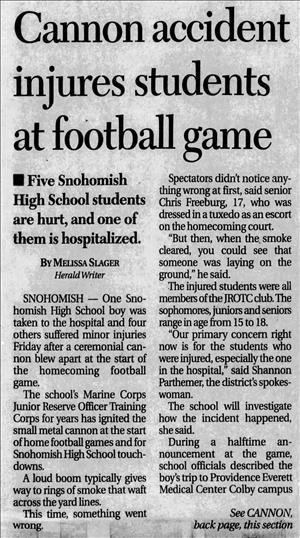On October 6, 2006, Snohomish High School student Brett Karch, 16, is severely injured when a ceremonial cannon, used at Snohomish High football games for more than 30 years, explodes after Karch pulls the trigger as directed by a fellow Marine Junior Reserve Officer Training Corps (JROTC) cadet. Karch suffers severe leg injuries. The story will take a few dark turns in the ensuing months before Karch receives a financial settlement for his pain and suffering and the cannon is mothballed.
Cherry Red
The accident happened at Snohomish High School's biggest football game of the year. It was homecoming and the Snohomish Panthers were set to face off against longtime rivals, the Everett Seagulls, at Snohomish’s Veterans Memorial Stadium. The cannon, a central part of game-day tradition, was positioned on the running track, just as it had been for decades. The cherry-red, 40-mm cannon was built by students in the Snohomish High School metal shop in the 1980s, replacing an earlier model from 1972. For more than 30 years, the cannon had fired before each game and after every Panthers touchdown. In fact, the cannon had been used just five hours earlier without issue, to kickoff the school’s annual Serpentine Parade.
The cannon was under the supervision of retired Marine Corps Colonel John Mack, the head of the JROTC program at the school. Col. Mack had a sterling reputation, with Snohomish High often regarded as a model for other JROTC programs. His cadets followed strict military protocols, including regular inspections of the cannon.
Usual Routine
On that fateful night, Karch and his fellow cadets performed their usual routine. The procedure involved rolling the cannon onto the field, packing the barrel with about five ounces of gunpowder, and then initiating a countdown. Cadet Alex Brown, the officer in charge, gave the command to fire. Karch pulled the trigger. While the crowd thought they heard the usual celebratory boom, there had actually been an unexpected explosion.
The next thing Karch knew, he was lying on the ground, several feet away, in a cloud of black smoke. A fist-sized piece of metal had struck his left leg, shattering the bone. In excruciating pain, he clutched his injured leg, while his fellow cadets were momentarily frozen in shock. Brown reported being unable to hear due to the loud explosion.
Within moments, firefighters and police officers on standby for the football game rushed to Karch's aid. He was quickly transported to a waiting ambulance. Four other students were treated for minor injuries, including powder burns. Despite the severity of the incident, the football game continued without interruption. Everett won 16-14.
Severe Injuries
Meanwhile, Karch was rushed to the hospital, where doctors fought to save his leg. The injury was severe – his leg had been perforated by shrapnel. After three surgeries and three weeks in the hospital, he was finally able to go home, but he would struggle to walk for months after the incident and spent nearly a year in rehabilitation. The injury also jeopardized his dreams for a future military career.
Local media coverage of the story was sparse, with just one article appearing in the Snohomish Tribune. But the Seattle Post-Intelligencer picked up the story, and soon, people from across the country began to criticize the city of Snohomish. The article shared that, while in recovery, Karch and his mother Mary Bissell received threatening emails and phone calls. It was reported that hostile community members feared the accident would end the town's beloved cannon tradition. The threats were serious enough that Karch was moved to a secure room in the hospital, and police were notified. Bissell was appalled. "As a mother, of course it's terribly distressing to me that anyone would make disparaging comments to my son," she said in a statement. "But rather than lingering on the negative, our family is completely focused on helping Brett recover" ("Boy Hurt By Cannon ...").
The city received more than 400 emails, many accusing the town of being "heartless" and "close-minded" for caring more about football traditions than an injured student. The town, depicted in the Post-Intelligencer article as a "close, conservative" community, was criticized for its apparent indifference.
Ensuing Controversy
As investigators gradually pieced together the truth, the story took a strange turn. In January 2007, a Snohomish woman, Dana Lynne Snyder, was charged with harassment for making threats against Karch. Snyder had tried to visit Karch in the hospital, but was barred from his room. She then made four phone calls, threatening to "make sure his other leg got blown off" when he returned to school. Reporters had initially linked the threats to the cannon tradition controversy, but it later emerged that Snyder’s anger stemmed from a personal dispute. Karch had once lived with Snyder and her son, and she was upset that Karch refused to testify for her in an unrelated civil case. The charges against Snyder were later dropped.
Bisell clarified her earlier comments, writing: "While it is true we have a past relationship with Snyder, we experienced negative comments from a variety of sources, and we felt these to be the result of a community that was more concerned with protecting its football traditions than with supporting my son’s recovery. Today, I am thankful that many kind individuals, organizations, and leaders in the Snohomish community have come forward to personally and publicly support Brett. The will-wishes will enable him to heal much more quickly" ("Threats Unrelated ...").
In the end, a lawsuit filed on behalf of Karch was settled with the Snohomish School District in March 2009. The district paid a $660,000 settlement for pain and suffering.
The cannon has not been used since.

